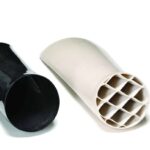Vehicle body made from cotton, hemp, and wood
“Lightweight” is an important buzzword in automotive engineering, and just as important in the aerospace sector, too. Carmakers are increasingly counting on fiber reinforced synthetics. These fibers, which are embedded into the synthetic matrix, give the material its additional durability. Exactly which material you choose to use depends on its eventual application. Thus, primarily carbon fiber is used in Formula 1 racing. However, one drawback is its high price; even its processing can be tough. These are the reasons why carbon fiber-reinforced plastics (CFRPs) have still not yet found their path into wide-scale serial production so far to date. Glass fibers, on the other hand, are certainly reasonably priced, but heavy by comparison. But this may soon change, thanks to some new research approaches by researchers at the Application Center for Wood Fiber Research HOFZET of the Fraunhofer Institute for Wood Research, the Wilhelm-Klauditz-Institut WKI in Braunschweig.
Combining advantages, eliminating disadvantages
The scientists are relying on natural fibers of botanical origin. Variants derived from hemp, flax, cotton and wood are about as affordable as glass fibers, and moreover have a lower density than the pendants made of glass or carbon. Another advantage: If you incinerate them at the end of their life cycle, they produce additional energy – without leaving residues. Nevertheless, their durability and stability don´t reach that of carbon fibers. ”Depending on the application, we are therefore combining carbon with various bio-based textile fibers,” explains Prof. Dr.-Ing. Hans-Josef Endres, head of the Application Center for Wood Fiber Research. The fibers typically exist as fabrics that are placed on each other accordingly and are embedded by the plastic matrix. “We use carbon fibers in those areas where the part undergoes intense mechanical stress; in other areas, it’s natural fibers. This way, we can leverage the strengths of the respective fibers and get rid of the disadvantages to a great extent”. The outcome: the parts are cost-effective, have a very high degree of durability, possess excellent acoustic properties and are substantially more ecological than pure carbon components.
Typically, you treat the surface of the natural fibers so that they can be run easily through the textile equipment, and can be processed as well as possible into fabrics – this is also referred to as “sizing the surface of the fiber”. While this is important for textile production, it is usually counterproductive, however, if composite materials have to be processed. “This is why, from a materials engineering perspective, we optimize the surfaces of the fibers,” says Endres. Specialized surface treatments or coatings are intended to ensure that the fibers can be combined and interact in the best possible way with the matrix or the plastic mass. The potential is vast: “By ensuring that the fibers bond to the matrix optimally, we can increase the durability of the materials by up to 50 percent,” Endres explains in concrete terms. While such surface treatments are customary with glass and carbon fibers, when it comes to use textile fibers for reinforcement, the researchers are treading on virgin territory.
The entire production chain in sight – all the way to waste disposal
The researchers are doing more than creating the new hybrid materials. They are also studying how the processing processes for these new materials can be implemented on an industrial scale. By the same token, they also have an eye on the proper disposal of hybrid materials. Because when it comes to recycling, fiber composite materials are a proverbial “tough nut to crack.” For instance, how can expensive carbon fibers be extracted from the matrix and recovered? With the hybrid materials they’ve engineered, the scientists are already considering in advance how these can be reprocessed or how, at least, individual materials components can be recovered for a new use or application. In doing so, they are pursuing various physical, thermal, and chemical approaches, depending on the material composition.
At the nature.tec professional trade show at the Grüne Woche from January 16 to 25 in Berlin, WKI will unveil and present various textile bio-based hybrid materials (Hall 5.2A). The researchers will also present fiber form-pressed components for the automotive industry there. Fibers inside these parts are embedded into a thermoplastic matrix – plastic, that is – which can be shaped at ultra-high temperatures, or into a duroplastic synthetic matrix that, once it has fully hardened, can no longer be formed.
Photo’s captation: a hemp composite material











